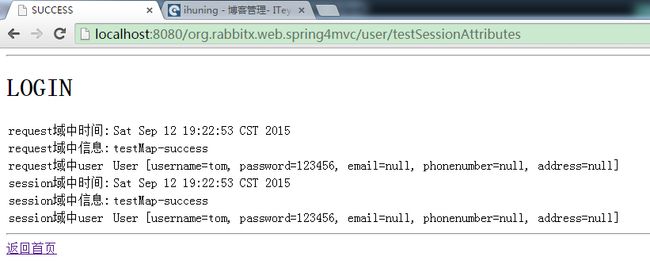处理模型数据
Spring MVC 提供了以下几种途径输出模型数据
1. ModelAndView: 处理方法返回值类型为 ModelAndView时, 方法体即可通过该对象添加模型数据
2. Map 及 Model: 入参为org.springframework.ui.Model、org.springframework.ui.ModelMap 或 java.uti.Map 时,处理方法返回时,Map 中的数据会自动添加到模型中。
3. @SessionAttributes: 将模型中的某个属性暂存到HttpSession 中,以便多个请求之间可以共享这个属性
4. @ModelAttribute: 方法入参标注该注解后, 入参的对象就会放到数据模型中
ModelAndView
控制器处理方法的返回值如果为 ModelAndView, 则其既包含视图信息,也包含模型数据信息。
添加模型数据:
MoelAndView addObject(String attributeName, Object attributeValue)
ModelAndView addAllObject(Map<String, ?> modelMap)
设置视图:
void setView(View view)
void setViewName(String viewName)
示例
1. 编辑JSP页面
<li>处理模型数据
<ul>
<li><a href="user/testModelAndView">ModelAndView处理方式</a></li>
</ul>
</li>
<%@ page language="java" contentType="text/html; charset=UTF-8"
pageEncoding="UTF-8"%>
<!DOCTYPE html PUBLIC "-//W3C//DTD HTML 4.01 Transitional//EN" "http://www.w3.org/TR/html4/loose.dtd">
<html>
<head>
<meta http-equiv="Content-Type" content="text/html; charset=UTF-8">
<title>SUCCESS</title>
</head>
<body>
<hr/>
<h1>LOGIN</h1>
<table>
<tr>
<td>时间:</td><td>${requestScope.time}</td>
</tr>
<tr>
<td>信息:</td><td>${requestScope.message}</td>
</tr>
</table>
<hr/>
<a href="/org.rabbitx.web.spring4mvc/index.jsp">返回首页</a>
</body>
</html>
<%@ page language="java" contentType="text/html; charset=UTF-8"
pageEncoding="UTF-8"%>
<!DOCTYPE html PUBLIC "-//W3C//DTD HTML 4.01 Transitional//EN" "http://www.w3.org/TR/html4/loose.dtd">
<html>
<head>
<meta http-equiv="Content-Type" content="text/html; charset=UTF-8">
<title>SUCCESS</title>
</head>
<body>
<hr/>
<h1>LOGOUT</h1>
<table>
<tr>
<td>时间:</td><td>${requestScope.time}</td>
</tr>
<tr>
<td>信息:</td><td>${requestScope.message}</td>
</tr>
</table>
<hr/>
<a href="/org.rabbitx.web.spring4mvc/index.jsp">返回首页</a>
</body>
</html>
2. 编辑处理类
/**
* 目标方法的返回值可以是ModelAndView类型,此类型中包含了(封装了)视图和模型信息
*
* SpringMVC会把ModelAndView的model中的数据放入到request域对象中
*
*/
@RequestMapping("/testModelAndView")
public ModelAndView testModelAndView()
{
String viewName = null;
ModelAndView modelAndView = new ModelAndView();
if(System.currentTimeMillis()%2 == 0)
{
viewName = LOGIN;
modelAndView.addObject("message", "success");
}
else
{
viewName = LOGOUT;
modelAndView.addObject("message", "failure");
}
modelAndView.addObject("time", new Date());
modelAndView.setViewName(viewName);
return modelAndView;
}
3. 测试
原理分析
1. 在方法testModelAndView中添加断点并使用调试模式启动服务器;
2. 在浏览器中点击相应连接启动调试;
3. 在调试栈中选择DispatcherServlet.doDispatch(HttpServletRequest, HttpServletResponse) line: 945;
此处的mv就是ModelAndView实例;
4. 进入此类的processDispatchResult方法;
5. 进入方法processDispatchResult中的render(mv, request, response);方法;
6. 在方法render中的view.render(mv.getModelInternal(), request, response);方法上使用Ctrl+T快捷键;
7. 选择AbstractView并进入;
8. 在AbstractView类中方法render中的方法renderMergedOutputModel上使用快捷键Ctrl+T进入“InternalResourceView”;
9. 查看类InternalResourceView中的renderMergedOutputModel方法中的exposeModelAsRequestAttributes方法;
/**
* Expose the model objects in the given map as request attributes.
* Names will be taken from the model Map.
* This method is suitable for all resources reachable by {@link javax.servlet.RequestDispatcher}.
* @param model Map of model objects to expose
* @param request current HTTP request
*/
protected void exposeModelAsRequestAttributes(Map<String, Object> model, HttpServletRequest request) throws Exception {
for (Map.Entry<String, Object> entry : model.entrySet()) {
String modelName = entry.getKey();
Object modelValue = entry.getValue();
if (modelValue != null) {
request.setAttribute(modelName, modelValue);
if (logger.isDebugEnabled()) {
logger.debug("Added model object '" + modelName + "' of type [" + modelValue.getClass().getName() +
"] to request in view with name '" + getBeanName() + "'");
}
}
else {
request.removeAttribute(modelName);
if (logger.isDebugEnabled()) {
logger.debug("Removed model object '" + modelName +
"' from request in view with name '" + getBeanName() + "'");
}
}
}
}
总结:
SpringMVC使用ModelAndView处理数据回传的本质是在ModelAndView中维护了一个ModelMap(这个类继承至LinkedHashMap<String, Object>),在服务器端,用户通过ModelAndView的addObject方法把数据添加到ModelAndView的map中。ModelAndView会在响应阶段通过遍历此map把数据添加到request域对中。
Map 及 Model
Spring MVC 在内部使用了一个org.springframework.ui.Model 接口存储模型数据
具体步骤:
1. Spring MVC 在调用方法前会创建一个隐含的模型对象作为模型数据的存储容器。
2. 如果方法的入参为 Map 或 Model类型,Spring MVC 会将隐含模型的引用传递给这些入参。在方法体内,开发者可以通过这个入参对象访问到模型中的所有数据,也可以向模型中添加新的属性数据
示例
1. 添加处理类
/**
* 目标方法可以添加Map类型的(实际上也可以是Model类型或者ModelMap类型)参数
*
* 实际map的类型是BindingAwareModelMap
*
* 处理本质是把此处map中的数据放入到ModelAndView对象中了
*/
@RequestMapping("/testMap")
public String testMap(Map<String,Object> map)
{
map.put("time", new Date());
map.put("message", "testMap-success");
System.out.println("----------testMap----------");
System.out.println("Map type: " + map.getClass());
return LOGIN;
}
@SessionAttributes
若希望在多个请求之间共用某个模型属性数据,则可以在控制器类上标注一个 @SessionAttributes, Spring MVC 将在模型中对应的属性暂存到 HttpSession 中。
@SessionAttributes 除了可以通过属性名指定需要放到会话中的属性外,还可以通过模型属性的对象类型指定哪些模型属性需要放到会话中
@SessionAttributes(types=User.class) 会将隐含模型中所有类型为 User.class 的属性添加到会话中。
@SessionAttributes(value={“user1”, “user2”})
@SessionAttributes(types={User.class, Dept.class})
@SessionAttributes(value={“user1”, “user2”},
types={Dept.class})
示例
1. 在处理类中添加处理方法;
/**
* @SessionAttributes 除了可以通过属性名指定需要放到会话中的属性外(实际上使用的是 value 属性值),
* 还可以通过模型属性的对象类型指定哪些模型属性需要放到会话中(实际上使用的是 types 属性值)
*
* 注意: 该注解只能放在类的上面. 而不能修饰放方法.
*/
@RequestMapping("/testSessionAttributes")
public String testSessionAttributes(Map<String,Object> map)
{
User user = new User();
user.setUsername("tom");
user.setPassword("123456");
map.put("user", user);
map.put("time", new Date());
map.put("message", "testMap-success");
System.out.println("----------testMap----------");
System.out.println("Map type: " + map.getClass());
return LOGIN;
}
2. 在处理类中添加Session域配置;
@Controller
@SessionAttributes(value={"user","time"},types={String.class})
@RequestMapping("/user")
public class UserController {
private final static String LOGIN = "login";
private final static String LOGOUT = "logout";
。。。
}
3. 编辑JSP页面
<li>处理模型数据
<ul>
<li><a href="user/testModelAndView">ModelAndView处理方式</a></li>
<li><a href="user/testMap">Map及 Model处理方式</a></li>
<li><a href="user/testSessionAttributes">@SessionAttributes处理方式</a></li>
</ul>
</li>
<%@ page language="java" contentType="text/html; charset=UTF-8"
pageEncoding="UTF-8"%>
<!DOCTYPE html PUBLIC "-//W3C//DTD HTML 4.01 Transitional//EN" "http://www.w3.org/TR/html4/loose.dtd">
<html>
<head>
<meta http-equiv="Content-Type" content="text/html; charset=UTF-8">
<title>SUCCESS</title>
</head>
<body>
<hr/>
<h1>LOGIN</h1>
<table>
<tr>
<td>request域中时间:</td><td>${requestScope.time}</td>
</tr>
<tr>
<td>request域中信息:</td><td>${requestScope.message}</td>
</tr>
<tr>
<td>request域中user</td><td>${requestScope.user}</td>
</tr>
<tr>
<td>session域中时间:</td><td>${sessionScope.time}</td>
</tr>
<tr>
<td>session域中信息:</td><td>${sessionScope.message}</td>
</tr>
<tr>
<td>session域中user</td><td>${sessionScope.user}</td>
</tr>
</table>
<hr/>
<a href="/org.rabbitx.web.spring4mvc/index.jsp">返回首页</a>
</body>
</html>
测试结果






